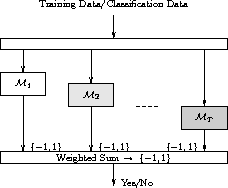
Desktop Survival Guide
by Graham Williams


|
DATA MINING
Desktop Survival Guide by Graham Williams |

|
|||
|

Boosting is an example of an ensemble model builder.
Boosting builds a collection of models using a ``weak learner'' and thereby reduces misclassification error, bias, and variance (, ,). Boosting has been implemented in, for example, Refer[c50]C5.0. The term originates with ().
The algorithm is quite simple, beginning by building an initial model from the training dataset. Those entites in the training data which the model was unable to capture (i.e., the model mis-classifies those entites) have their weights boosted. A new model is then built with these boosted entities, which we might think of as the problematic entities in the training dataset. This model building followed by boosting is repeated until the specific generated model performs no better than random. The result is then a panel of models used to make a decision on new data by combining the ``expertise'' of each model in such a way that the more accurate experts carry more weight.
As a meta learner Boosting employs some other simple learning algorithm to build the models. The key is the use of a weak learning algorithm--essentially any weak learner can be used. A weak learning algorithm is one that is only somewhat better than random guessing in terms of error rates (i.e., the error rate is just below 50%). An example might be decision trees of depth 1 (i.e., decision stumps).